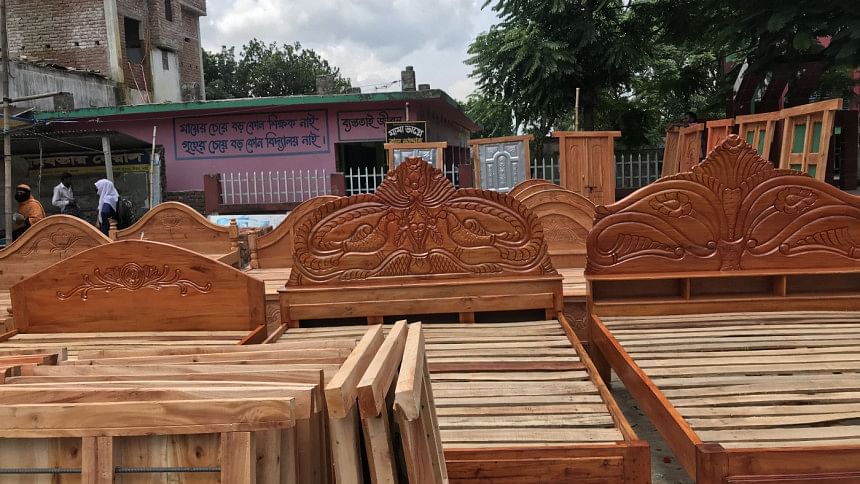Understanding Rural Transformation 2.0 in Bangladesh

During a recent road trip to Faridpur-Magura-Jashore-Jhenaidah-Kushtia region with a colleague who hails from this region, I had the opportunity to observe a part of rural Bangladesh, an enduring personal interest. We drove and walked around, stopped at places, and struck casual conversations with local people about anything and everything. What a krishok (farmer) at Katalmari village in Kushtia told me about the future of agriculture was perplexingly insightful. When a young entrepreneur in Magura described his busy daily schedule, I questioned my own inherited understanding of the village youth. There were many other villagers whose insights educated me broadly about what is going on in Bangladeshi villages, although I am increasingly unable to define what a village is, relative to an urban centre.
The transformation of rural Bangladesh is not new. Rural Transformation 1.0, so to speak, took place during the 1980s and 1990s. Its catalysts include the following: Rural electrification from the 1980s onwards (the Bangladesh Rural Electrification Board was established in 1977); mechanised irrigation (first with the use of electric water pumps and then shallow machines), allowing increased cropping; mechanisation of agriculture (i.e. power tillers, tractors, automated crop plantation, etc) leading to greater agricultural productivity; an extensive network of rural roads spearheaded by the Local Government Engineering Department (LGED) during the late 1980s and 1990s, connecting the rural hinterland with urban centres; microcredit as a bottom-up financial tool to alleviate rural poverty; and remittances sent by the Bangladeshi diaspora that had a seismic impact on the rural economy. Another watershed moment during the 1980s and 1990s was the creation of upazila as an administrative unit of semi-autonomous local governance. By 2000, a significantly transformed rural Bangladesh was an accepted reality.
During my recent trip, I was interested in exploring Rural Transformation 2.0, the next generation of rural change during 2000-2020. I had six observations, some of which are abstract or qualitative in nature, while some are more tangible or discernible.
The end of the remote village
Our traditional mental image of the village as a "remote" place has collapsed. Roads penetrate deep inside the heart of rural Bangladesh. Motorbikes or "nosimons" can take you to a nearby town in minutes. It would be nearly impossible to find a rural person without a mobile phone. While improved roads, mechanised transportation, mobile phones, TVs, and other services helped, the collapse of the "remote rural" is also in the nature of imagination. Villagers don't feel isolated anymore and are acutely aware of the increasingly blurred boundaries between the village and the town. It is both a physical and a mental reorientation that shapes people's worldviews, as well as their own image of being villagers. This self-image and self-consciousness affect how they do what they do – be it farm or non-farm work, or both.

A new scale of non-farm work
The proliferation of diverse non-farm activities in rural areas challenges our historical sense of the village, traditionally seen as the epicentre of an agrarian economy. The 2016-17 Labour Force Survey by the Bangladesh Bureau of Statistics (BBS) estimated that non-farm work accounts for 59 percent of rural employment – a major increase from the 2010 level. The curve is steadily going upwards. How and whether these activities are related to agriculture – directly or indirectly – remain open research questions.
As I have seen during my trip, the rental business of both locally produced and imported agricultural machinery is now a common scene in rural markets. Langol (plough), it seems, is ready to become the artefact of a future national museum of agro-revolution in Bangladesh. Mobile phone and consumer electronics repair shops abound. Businesses such as transportation, prefabricated building materials like reinforced pillars, toilet rings, and stoves, and furniture shops are now integral parts of the rural economy. Homestead forestry and lumbering as a commercial enterprise have emerged as a significant economic driver. With a diminishing agricultural labour force, commercial forestry – generally labour-independent – has become an attractive option for many rural families, particularly those with college-going children who find certain stigma in traditional agricultural work. Organically designed chayer tong (tea stalls), with TVs and ample sitting areas, have become the (male) social hubs of village life.

The rural entrepreneur
The new rural entrepreneur is a quintessential multitasker. I have met so many villagers who are not static with one job. They do farm, farm-induced, and non-farm work all at once. Palash of Shibrampur village in Magura works at the Sadar Sub-Registry Office as a scribe, while also leasing land from others to cultivate papaya, dragon fruit, lemon, and banana, and personally taking care of his seven "investment cows" in the wee hours and late in the evening. Bobita Debnath of Mirpur upazila in Kushtia is an entrepreneur who runs a thriving rural "7-Eleven," or a convenience store. I spoke with a young entrepreneur named Mappi, who has a diploma in textile engineering and worked for several years in Dhaka. Now wishing to be his own boss, he returned to his ancestral land and is now running a successful business, assisting rural clients to fill out digital applications for a variety of positions and online forms for Covid tests. An entrepreneurial culture, most likely inspired by peer competition, remittance, a desire to transcend labour-intensive agrarian life, government's policy support, NGO advocacy, and digital access to services, has taken hold in rural Bangladesh.
The rise of the rural middle class
The rise of a rural "middle class" has transformed the social landscape of Bangladeshi villages. Split between a communitarian pastoral sentiment and an urban, individualistic, and consumerist lifestyle, this middle class demonstrates a neighbourly attitude, while also building high boundary walls to fortify its generously coloured and multi-storey brick house. The burgeoning class either owns or would like to own the usual consumer electronics or appliances, like a TV or a fridge. About a month ago, on the way back from a village under Chandanaish upazila in southern Chattogram, I noticed something that I thought I had never seen before on a rural street. It was a one-man paddle van, bringing new Walton television sets to a village electronic shop or shops.
The new rural middle class embodies the same secret shame that its urban counterpart does. When I requested a group of about 20 people at a chayer tong in a Satkhira village to raise their hands if they didn't own a TV or a fridge, nobody did. There is no definitive data on Bangladeshi rural households' ownership of consumer electronics. One person later told me quietly that there were people in the group who didn't own these items, but they didn't want to disclose their household conditions, for it would diminish their social status in the eyes of their neighbours. The rural middle class has left behind the natural toothbrush called miswak to embrace toothpaste and plastic toothbrush to maintain their oral hygiene. Colourful toothpaste advertisements, among other product ads, are a common sight on the boundary wall of rural houses or shops.

A new landscape
The traditional rural landscape of the Bengal delta – defined by the horizontal sweep of the green paddy field, tree-filled homestead, and snaking canals – is now frequently punctuated by building types that we are accustomed to seeing only in urban areas. A thriving construction industry and its affiliated businesses are changing the nature of rural life. An urban-style culture of advertisement has permeated rural Bangladesh. Large billboards, featuring message-driven ads for cement, steel, light bulbs, wall paint, fans, and a host of building materials, rise from paddy fields, seeking the attention of both villagers and passers-by.
The environmental policy implications of rural areas being transformed by single-family residential houses, multi-storey apartment buildings, ostentatious convention halls, fire stations, fuel refilling stations, cold storages, and industrial complexes are many. Without proper drainage, waste collection, building regulation, and environmentally conscious planning, rural areas are likely to become a hodgepodge imitation of urban Bangladesh. Technical capacity building at the union council office or the UNO (chief executive officer of an upazila) office is essential to tackle such complex environmental challenges. How we provide civic services to rural areas without compromising their "rurality" and environmental characters should be a key policy question.

Digital rurality
Access to online services and information has been reconfiguring rural life, despite a low-level digital literacy among Bangladesh's rural population. A 2019 pre-Covid survey by Brac Institute of Governance and Development (BIGD) shows that more than half of Bangladesh's rural population have no familiarity with the internet. However, a significant mental shift may have taken place during the Covid closure. Limited mobile-based classes had an impact on digital learning. Mobile financial services like bKash and Nagad have eliminated the choking presence of the middleman. Thanks to the Digital Bangladesh agenda, digital cable infrastructure today covers about 70-75 percent of Bangladesh's landmass, according to the Urban Development Directorate, a government regulatory agency under the Ministry of Housing and Public Works. To optimise this expanding infrastructure, the Digital Bangladesh agenda must establish a symbiotic relationship between digitised services, businesses, and information exchange, and the digital literacy of the people who access these services.
A bunch of questions kept bouncing around my mind as I thought about the promises and perils of Rural Transformation 2.0. For me, the central question was: What is the future of agriculture in Bangladesh, and how will that future transform rural life? The answer depends on whom you ask. What the krishok of Katalmari told me reminded me of the defiant statement of Ma Joad, the matriarch of the Joad family in John Steinbeck's 1939 novel, The Grapes of Wrath, "They can't wipe us out; they can't lick us. We'll go on forever … cause we're the people." Ma Joad's thunder captures the gritty resilience of the American working class against the anxious backdrop of the 1930s Great Depression. The Katalmari farmer was similarly defiant. "Until my body permits, I'll go on cultivating my land. I will decide when and whether I cultivate my land." I sensed that he was alluding to his own resistance against the corporatisation of agriculture. A betel leaf businessman from Khajura village in Jashore warned of jomi'r obhishap (the curse of the land). If we overexploit the land with multicropping, exceeding the bearing capacity of the land, we will inevitably draw nature's wrath, he reasoned.

Much research is needed to ascertain the environmental cost of progress.
My own sense is that the future of rural Bangladesh will be shaped by the politics of land acquisition. Large conglomerates like Akij Group or Pran-RFL Group (Pran is short for Programme for Rural Advancement Nationally) will be hungry and hungrier for rural land to set up their production complexes, and industrially harvest the agricultural products they need for their supply chain. Land acquisition will be a social war and, therefore, messy.
To end on an optimistic note, Rural Transformation 2.0 should be a research gold mine.
Dr Adnan Zillur Morshed is an architect, architectural historian, urbanist and professor. He teaches in Washington, DC, and serves as the executive director of the Centre for Inclusive Architecture and Urbanism at Brac University.

 For all latest news, follow The Daily Star's Google News channel.
For all latest news, follow The Daily Star's Google News channel. 







Comments